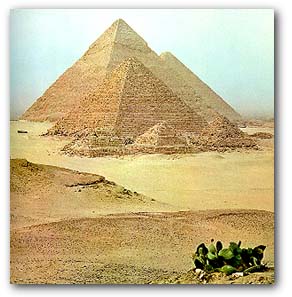| Pyramid of Chephren
(Khephren)(Khafre)  Chephren, often called the "Second Pyramid", is built next to the Great
Pyramid of Khufu (Cheops). Chephren is the son and successor of Khufu and Hensuten.
Khufu's other son and also successor, Ra'djedef, started constructing his own pyramid at Abu
Rawash, which is north of Giza. Chephren's pyramid is designed more modestly than Khufu's.
The Chephren pyramid originally was 10 feet (3m) shorter and 48 feet (14.6m) more narrow
at the base. The estimated weight of all the stones in the pyramid is 4,880,000 tons. Because it
is built higher on the plateau, it looks taller from most angles than Khufu's pyramid. The slope
of the angles is higher, 53 degrees compared to Khufu's 51 degrees. Chephren, often called the "Second Pyramid", is built next to the Great
Pyramid of Khufu (Cheops). Chephren is the son and successor of Khufu and Hensuten.
Khufu's other son and also successor, Ra'djedef, started constructing his own pyramid at Abu
Rawash, which is north of Giza. Chephren's pyramid is designed more modestly than Khufu's.
The Chephren pyramid originally was 10 feet (3m) shorter and 48 feet (14.6m) more narrow
at the base. The estimated weight of all the stones in the pyramid is 4,880,000 tons. Because it
is built higher on the plateau, it looks taller from most angles than Khufu's pyramid. The slope
of the angles is higher, 53 degrees compared to Khufu's 51 degrees.
There is no evidence that anyone was ever buried in the main chamber. No inscriptions have
been found in the pyramid, however there is a sarcophagus in the main chamber. There are
two entrances that lead into the pyramid which are placed one directly above the other. The
upper entrance is 50 feet (15m) above the ground. This is the one that is used for entrance
now. A narrow passage leads into a large limestone chamber. This passageway descends at a
25 degree angle to the chamber. The walls are lined with red granite. This inner chamber is
quite large, 46.5' x 16.5' x 22.5' (14.2m x 5m x 6.9m). The roof of the chamber is set at the
same angles as the pyramid face. This is designed to take the weight of the pyramid, as is the
relieving chambers in Khufu's pyramid. Apparently the roof designed this way has worked, the
pyramid has not collapsed. The lower corridor is directly under the upper corridor. This lower
corridor once contained a portcullis, which could be let down to prevent entry. This corridor
declines on the same angle as the upper and eventually joins into the upper. Once joined, the
passageway leads into the inner chamber. Located in the lower passage is a burial chamber
that is apparently unfinished and unused. It is in the bedrock under the pyramid. The
passageway leads through this chamber and joins the upper corridor.
The top of the pyramid still has some of the limestone casing that once covered the entire
pyramid. There may have been a change in the method of positioning the blocks that has kept
these pieces still intact. It gives the appearance of a white cap on top of the pyramid. As was
Khufu's pyramid, the pyramid of Chephren had been looted before it was entered in 1818 by
Belzoni.
The Mortuary Temple of Chephren is to the east of the pyramid and is better preserved than
Khufu's temple. Chephren's temple is more elaborate, although the statues and other contents
have been stolen than his father's. Some of the limestone walls had granite casing, which is still
present in some places. Parts of a small sanctuary, outhouses, a courtyard and a large hall with
pillars still remain. A causeway that connected the Mortuary Temple to the Valley Temple is
better preserved than any other causeway. It was hidden in the sands until Mariette found it in
1852. The causeway is 500m long and was lined with red granite which protects the
limestone. There are two entrances to the temple that face east and lead into a T-shaped hall
which has huge pillars. Twenty-three statues of Chephren were found in this hall. The only one
which remains intact is in the Egyptian Museum. This statue, which is possibly the most famous
Egyptian statue, shows Chephren sitting in his throne with a hawk perched on the back of the
throne. Chambers can be found on the south side of the hall, but a passage that joined the
causeway is now closed off to visitors.
|





